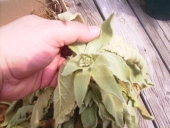Fred Morgan wrote:One thing that is standard is to prune as soon as you can, the earlier the better. It is much nicer if you can just rub off the bud. I guess you could say that isn't pruning, but I don't know of any forester who would think it isn't. Most of our pruning is done on very young wood, you don't want to be lopping off limbs normally. If you are cutting more than 2 inches, you have waited too long is the conventional wisdom.
One issue with over pruning is waterspouts. It is what you want to avoid. A method of just rubbing off buds would definitely help in that issue.
I am not trying to disagree by the way, but really, if you are training the tree, aren't you pruning? You all have managed to confuse me I think. 
We bought our house a year and half ago. It has a small orchard of semi-dwarf apple and pear trees that are about 20 years old. They were probably pruned once. So I took a pruning class through the cooperative extension. It was held at a commercial orchard. The most memorable part of the class was where we approached the last trees of the class, a couple of gnarled Wolf Rivers. The instructor starts up his chainsaw and says." if you are reviving an old tree you should remove 30% the first year." He takes his chainsaw and hacks away 30%. Then he says, " the second year you remove another 30%" AND then he removed another 30%!
So the first year here I took my hand pruners and loppers to 4 of the twelve trees and just removed any crossed branches that were rubbing. I removed any obvious dead branches. I wanted a little more airflow in the tree because we have more likelyhood for fungal diseases in the wet northeast. But I made a point not to hack too much off. I wanted more light on the interior but I did not get aggressive. Harvest was great. We have the full compliment of diseases and pests at this point but I was able to dry and sauce plenty and our sheep enjoyed them as well. We scythed the grass between the trees for our sheep and pastured the sheep with our portable fence in between the trees.
This year, I took the same approach with the rest of the trees. I found a lot of fireblight on the trees lower in the orchard and concentrated my efforts on these parts of the trees. With the four trees I pruned last year I did cut one or two larger limbs but not much else. My long term plan is to plant guilds under all the trees and fence our sheep between the trees. I just started my first guild this spring.







